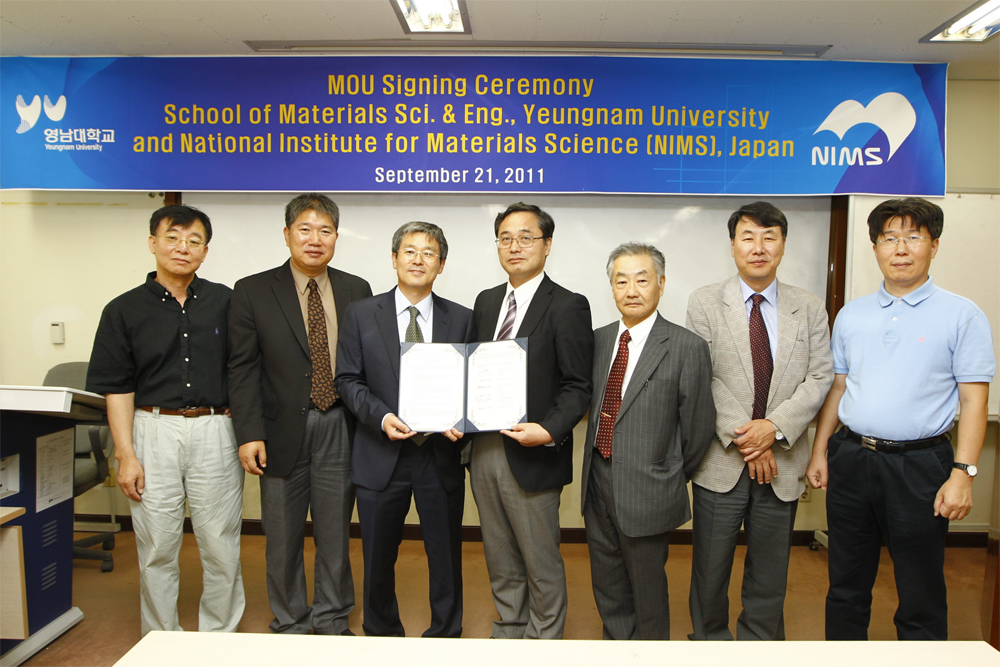Joint Research on Nanoceramics with the National Institute for Materials Science of Japan N
No.88445- Writer YU
- Date : 2012.03.05 17:44
- Views : 10398
School of Materials Science and Engineering of YU and NIMS of Japan sign research exchange MOU
[September 21, 2011]
For international research and exchange in the nanoceramics sector, Yeungnam University (president Lee, Hyo-soo) teamed up with National Institute for Materials Science of Japan (NIMS). NIMS was founded as the ‘National Institute for Research in Inorganic Materials’ in Tsukuba, Ibaraki. Today, it is a world-class research institute that is leading the development of advanced materials needed for the future of humanity based on nanotechnologies.

School of Materials Science and Engineering – NIMS, Research Exchange MOU Signing Ceremony
At 3pm on the 21st, the School of Materials Science and Engineering (dean Lee, Jai-yeoul) and NIMS of Japan (National Institute for Materials Science, director of Materials processing section, Yoshio Sakka) signed a research exchange MOU at the Yeungnam University Materials Science and Engineering Building and promised to cooperate for the promotion of exchange.
Accordingly, based on the manufacturing cooperation of advanced ceramics that applied SPS (Spark Plasma Sintering) that applies both heat and pressure using electric current from the nano-powder materials, the two organizations will cooperate on ▲exchanging researcher (internships), ▲sharing research theses and information, and ▲conducting collaborative research.
Nanoceramics are materials developed for the purpose of giving functions not existing in regular ceramics or greatly enhancing the performance of existing functions by designing and controlling the structure of nonorganic minerals such at metal oxides, nitride and carbide at nano sizes (1/1,000,000,000m). R&D as core parts for iron furnaces, high precision engine parts, aerospace parts, cutting tools that are highly durable with anti-abrasion properties, bio materials, solar cells, fuel cells, and semiconductors are being conducted, and some have already become commercialized.
At this MOU ceremony, Lee, Jai-yeoul, dean of the Yeungnam University School of Materials Science and Engineering, said, “NIMS is a national research institute that represents Japan in the materials sector. We began exchanging intern students from last summer vacation, even before signing this MOU, to provide the opportunity to acquire technologies and information of this advanced sector, and the effects were very promising. We are planning to continuously expand our global network and diligently pursue collaborative research between our organizations, while also enhancing cooperation both nationally and internationally.”
In response to this, Dr. Yoshio Sakka (55), director of the NIMS material processing sector, said, “By signing this MOU with Yeungnam University which possesses considerable research capacities and achievements in the materials sector, we are now able to accelerate our research on cutting-edge nanoceramics such as in aerospace sectors.”
After the MOU signing ceremony at 4pm, a seminar under the theme ‘Research Status of NIMS and International Joint Research’ was held. Dr. Yoshio Sakka, the unit director, stood as the speaker and spoke about ‘Research Status of NIMS and International Joint Research’, followed by Professor Han,Young-hwan of the Yeungnam University School of Materials Science and Engineering, who spoke about ‘School of Materials Science and Engineering SPS Research Status and Joint Research.”
Through this, the Yeugnam University of New Materials Engineering is expected to hold international symposiums and publish SCI thesis books with the purpose of collaborative research on SPS (Spark Plasma Sintering), with hopes to become a hub for domestic nanoceramics SPS research.
※ Spark Plasma Sintering: quick sintering method through heat diffusion and electric diffusion of high energy with high temperature discharge plasma that occurs suddenly through sparks by injecting direct pulse electric energy between particles, while also giving mechanical pressure